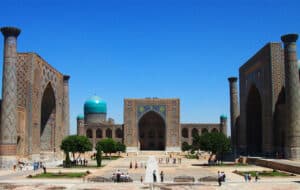Table Of Contents
Ulugbek Observatory Travel Guide
1. Introduction
Perched on the outskirts of Samarkand, the Ulugh Beg Observatory—built in the early 15th century—once ranked among the most advanced astronomical facilities in the world. Its founder, Ulugh Beg (1394–1449), was not only a Timurid ruler but also a renowned astronomer and mathematician. While the observatory fell into ruin after Ulugh Beg’s untimely death, modern excavations and restorations now allow visitors to appreciate its historical significance and scientific brilliance.
Historical Note:
“Ulugh Beg’s name among astronomers stands like a shining star in the firmament of scientific progress.”
– A modern historian reflecting on Ulugh Beg’s impact.
2. The Visionary Behind the Observatory: Ulugh Beg
- Royal Lineage: As the grandson of the conqueror Timur (Tamerlane), Ulugh Beg ruled parts of the Timurid Empire, focusing more on scholarly pursuits than on military expansion.
- Passion for Astronomy: From an early age, Ulugh Beg showed a keen interest in mathematics and the movement of celestial bodies. He transformed Samarkand into a cultural and intellectual hub, funding madrasahs and attracting scholars from across the Islamic world.
- Profound Contributions:
- Star Catalog (Zij-i Sultani): Ulugh Beg and his team produced incredibly accurate data on 1,018 fixed stars, surpassing many older records in precision.
- Lunar & Solar Calculations: Observations and calculations made at the observatory laid the groundwork for more accurate predictions of eclipses and planetary motions.
The Tragic End
Despite his scholarship and the respect he commanded among intellectuals, Ulugh Beg’s reign faced internal strife. He was assassinated in 1449—allegedly on the orders of his own son amid political intrigue and rivalry. After his death, the observatory fell into disuse and was ultimately destroyed by religious hard-liners who saw astronomy as conflicting with certain orthodox beliefs.
Sad Footnote:
“He measured the stars but could not foresee the tragedy beneath his own roof,” is a local saying that poignantly reflects his fate.
3. Building the Observatory
Architectural Genius
- Exact Meridian Alignment: The observatory was constructed so that its main instrument, a massive meridian arc (sextant), aligned perfectly with the local meridian—meaning north-south. This precise orientation allowed for highly accurate measurements of celestial bodies as they crossed the observer’s local sky.
- Innovative Construction: Built as a three-story cylindrical structure (much of which is now lost), the observatory housed several advanced instruments. Its main attraction—partly excavated—remains the monumental underground arc that functioned as a giant sextant.
Funding & Resources
- Royal Patronage: As ruler of the region, Ulugh Beg had access to state funds and skilled artisans. His passion attracted top mathematicians and astronomers—like Qadi Zada al-Rumi and Ali al-Qushji—who helped refine instruments and data analysis.
- Education Hub: The observatory formed part of a broader scholarly network in Samarkand, which included Ulugh Beg’s madrasah at the Registan. Students and researchers transitioned between these institutions, fostering a collaborative environment.
4. The Famous Sextant: How It Worked
What is a Sextant?
A sextant is typically a handheld instrument for measuring the angle between two visible objects (often the horizon and a celestial body). However, Ulugh Beg’s sextant was on a massive scale, sometimes called a meridian arc or Fakhri sextant:
- Size & Scale: Extending over 36 meters (around 118 feet) in radius, this arc was carved into a trench spanning the observatory’s interior.
- Stone & Marble Inlay: The measuring arc featured stone or marble steps marked with precise degree calibrations.
The Simple Explanation of Its Operation
- Aligning with the Meridian: Because the instrument was oriented exactly north-south, astronomers observed celestial objects only when they passed the local meridian (the highest point in the sky).
- Measuring Angles: As a star or the sun crossed the meridian, astronomers measured its angular height (altitude) above the horizon using the inscribed markings on the sextant.
- Collecting Data: By comparing altitude measurements across days, weeks, and months—and correlating them with known time references—Ulugh Beg’s team calculated key celestial parameters: star positions, the length of the solar year, and more.
- Remarkable Precision: The observatory’s careful alignment and the arc’s considerable size allowed for measurements that were extraordinarily accurate—some star position data remained unsurpassed until the 17th century.
Fun Fact:
The larger the sextant (or meridian arc), the finer the possible measurement. That’s why Ulugh Beg’s massive design gave him such impressive accuracy compared to smaller instruments of the era.
5. Historical Influence & Global Impact
- Astounding Accuracy:
- Many of Ulugh Beg’s star coordinates had negligible errors when checked centuries later by European astronomers using telescopes.
- His calculations for the length of the solar year were off by only a few seconds compared to modern figures.
- Impact on Future Astronomical Studies:
- Persian & Ottoman Astronomers built upon the data, refining celestial models across the Islamic world.
- Influenced the rise of Copernican astronomy in Europe indirectly, as knowledge traveled via trade routes and translated texts.
- Legacy in Modern Science:
- Ulugh Beg is often praised as a pioneer who bridged earlier Greek and Islamic astronomy with emerging Renaissance science.
- In the 20th century, interest in his work resurged, leading to recognition of his place among history’s greatest astronomers.
6. Planning Your Visit
Location & Access
- Where: The observatory site lies on a slight elevation on the outskirts of Samarkand, ~5 km northeast of the Registan.
- How to Get There:
- Taxi: Easiest option from central Samarkand, taking around 15–20 minutes.
- Local Buses: Some city routes pass near the observatory; check schedules locally, as they can be irregular.
Tickets & Hours
- Opening Times: Typically 9:00 AM–6:00 PM (seasonal variations possible).
- Entry Fee: Around 25,000–40,000 UZS for international visitors; often includes access to a small adjacent museum.
Onsite Museum
A modest on-site museum displays artifacts, replicas, and explanatory panels about Ulugh Beg’s life, the sextant, and medieval astronomy. It’s a great way to visualize how the observatory looked before its partial destruction.
7. Photography Tips & Highlights
- Capturing the Excavated Arc:
- Wide-Angle Lens: To encompass the underground trench and the arc’s curvature in one frame.
- Consider the Angle of Light: If you go mid-morning or late afternoon, the slanting sunlight may add depth and shadow to emphasize the arc’s size.
- Museum Exhibits:
- Use a Fast Lens/High ISO: Indoor lighting is often dim. Request permission before using flash, as some exhibits prohibit it.
- Detail Shots: Zoom in on charts, diagrams, or historical texts to capture the intricacies of 15th-century astronomy references.
- Observation Hill & Surroundings:
- Panoramic Views: The observatory is slightly elevated, providing vantage points over modern Samarkand. Great for scenic shots of the city with the ancient site in the foreground.
- Sunset Silhouettes: If you stay until evening (when permitted), the silhouette of the observatory site against the sky can be striking.
8. Practical Tips & Etiquette
- Dress Comfortably: You’ll be walking around outdoor excavation zones with some uneven terrain.
- Respect the Exhibits: Don’t climb on or touch the excavated structures—they’re fragile.
- Guides & Interpretations: Hiring an official guide can enrich your visit with stories about Ulugh Beg’s life, the function of each instrument, and the post-15th-century fate of the site.
- Hydration & Sun Protection: Summers in Samarkand are hot; bring a water bottle, hat, or umbrella.
9. Nearby Attractions
- Registan Ensemble: Samarkand’s most iconic square, featuring three grand madrasahs—Ulugh Beg (yes, he built one here too!), Sher-Dor, and Tilya-Kori.
- Bibi-Khanym Mosque: Commissioned by Timur, once one of the largest mosques in the Islamic world.
- Shah-i-Zinda Necropolis: A visually stunning alley of mausoleums, famous for its vibrant, intricate tilework.
- Gur-e-Amir Mausoleum: The final resting place of Timur and other Timurid royalty, showcasing a spectacular azure dome.
10. Conclusion
The Ulugh Beg Observatory stands as a testament to one man’s extraordinary quest to map the stars with unerring precision. From the massive meridian sextant that pushed the boundaries of medieval science to the tragic fate that befell its founder, this site embodies both the triumph and fragility of human endeavor.
Reflective Thought:
“In the silence of the cosmos, Ulugh Beg heard the music of the spheres—and captured it with an arc etched into Earth.”
– A modern writer summing up Ulugh Beg’s pioneering spirit
Visiting the observatory reminds us that scientific passion can flourish in any era—its data bridging centuries, cultures, and continents. Stand by the excavated arc, gaze upon the city below, and imagine the starry nights when Samarkand was not only a crossroads of trade, but also a beacon of astronomical discovery illuminating the entire world.
Related Tours




